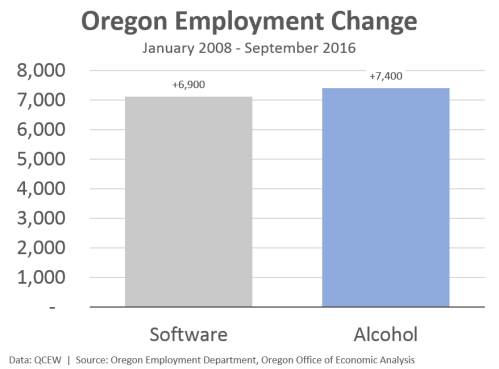By Josh Lehner
Oregon Office of Economic Analysis Blog

Happy Friday! In the showdown you didn’t know you wanted but now glad you have, Oregon’s alcohol cluster has added more jobs than the state’s software industry since the start of the Great Recession. This edition of the Graph of the Week has been a regular in our office’s slide deck for some time now but we haven’t shown it here on the blog yet. Our office uses this chart as the starting point to talk about three things in particular.
First, software is clearly a high-wage and fast-growing sector. That said, Oregon’s historical high-tech strength has been in hardware, with a below-average share of jobs in software. While highly productive and very important, hardware is no longer a job growth industry. Software, conversely, started from a low base and is growing quickly. The state needs and welcomes all of these jobs we can get as they are helping to diversify our economy. For more, see our office’s summary of Oregon’s high-tech sector overall, and our look at software, outposts and critical mass.
Second, Oregon’s alcohol cluster continues to boom. This includes the state’s breweries, distilleries, wineries in addition to distributors, specialty retail shops and bars. It does not include restaurants and so misses out on the brewpubs that are classified as restaurants. While wages are not as high in the alcohol cluster, it remains an important industry for a few reasons. At its roots, it is value-added manufacturing. It takes commodities and raw ingredients and turns them into a more valuable product that is then sold around the world. The impact really goes beyond the bottles and cans however. The broader cluster of agricultural products, equipment manufacturers and suppliers, and local design, marketing and consulting services are key. When a new brewery opens in another state, they look to Oregon-based firms to help them get started. Additionally, the geographic footprint of the industry is widespread and not just concentrated in the larger urban areas. For more, see our office’s beer report and look at alcohol exports.
Third, from an economic perspective, our office hopes that the newly legalized recreational marijuana market follows in the footsteps of the alcohol cluster. It is not so much the growing and retailing of the product that we’re looking for. That will come regardless and over time the market will be commoditized like any other. It’s really broader than that were the real economic impact will come from. It’s about the value-added manufacturing — extracting oils, creating creams, making edibles. It’s about building up the broader cluster of lab testing equipment, and branding and design companies so that when another state legalizes marijuana they look to Oregon firms to help them. Right now, we’re still in the infant stages of these developments and is something to keep an eye on moving forward. Our friends at the Employment Department recently shared some data that showed there are about 3,000 payroll jobs in the sector, however there have been over 6,000 applications approved for those applying to handle marijuana. Private sector estimates of the number of jobs are higher still, including jobs not covered by unemployment insurance.
Disclaimer: Articles featured on Oregon Report are the creation, responsibility and opinion of the authoring individual or organization which is featured at the top of every article.

